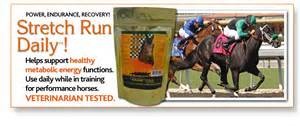Original Publish Date January 2015
Stretch Run Daily™ supports metabolic energy functions in the horse during the training and racing season.
Horses are among the world’s most supreme natural athletes. Their ability is due to their specialized circulatory system and respiratory system that can accommodate large oxygen demands of the muscles when a horse exercises.
As a manner of speaking, while the circulatory and respiratory systems represent the horse’s engine, the food a horse consumes is the fuel. In turn, the fuel is converted to nutritional energy that powers the muscles. The equine circulatory system transports blood throughout the horse, putting to use the heart, arteries, veins and capillaries.
Horse power dictated by heart On average, the size of a horse’s heart is about 1 percent of its body weight. That means a 1,000-pound horse will have an 8- to 10-pound heart. Thoroughbreds tend to have slightly larger hearts in proportion to their body size, while draft breeds have hearts that weigh only 0.6 percent of their body weight.
Similar to a human’s heart, a horse’s heart has four chambers; two atria that rest above two ventricles. Blood that returns from the body enters the right side of the heart and the deoxygenated red blood cells fill the right atrium.
According to Equimed.com, the blood volume of a horse is about 8 percent of their body weight, meaning an average adult horse that weighs 1,100 pounds has roughly 40 liters of blood circulating through its body.
In order to supply oxygen throughout the body, air passes through the nostrils and along a long nasal cavity before it passes into the larynx and pharynx. After going through the trachea, the air reaches the bronchial trees within the lungs. The alveoli is where gas exchange occurs and where the circulatory system receives oxygen and delivers it to tissues throughout the body, as well as nutrients absorbed from the digestive system.
Max output The main objective of the respiratory system is to exchange oxygen and carbon dioxide. Depending on the level of exercise, the volume of carbon dioxide will vary. For example, a resting horse generally has a very low respiration rate, only taking 10 to 14 breaths or fewer per minute. Adult horses have a resting heart rate between 28 and 44 beats per minute.
However, this rate rises gradually as the level of exercise increases. When a horse engages in intense exercise, the body’s tissues demand more oxygen, meaning more CO2 must be removed. In order to accomplish this, respiration rate increases. The average heart rate is 80 beats per minute at the walk, 130 bpm at the trot, 180 bpm at the canter and up to 240 bpm while galloping.
Importantly to horse trainers, there is a limit to the minute volume (the amount of air inspired and expired in one minute) that can be reached during maximal intensity exercise. At a heart rate of 200 beats per minute or over – the max – the blood leaving the lungs may not be carrying enough oxygen to sufficiently provide the tissues. This case is known as arterial hypoxia. According to The Horse, the respiratory system can deliver the necessary amount of oxygen, albeit for a limited time, when the heart rate is 180 per minute or less. When the heart rate surpasses that point, it becomes unhealthy for the horse.
Horse trainers should try to strike the sweet spot for horses’ hearts. Help your equine recover faster with supplements before and after intense training.
Stretch Run Daily™ supports metabolic energy functions in the horse during the training and racing season. Horse trainers can use it daily while training for performances horses. It is a top supplement for horse performance.
Stretch Run™ is a pre-race, pre-event health product, to help maintain healthy metabolic energy functions in the horse. For performance horses engaged in racing or other strenuous activity.







